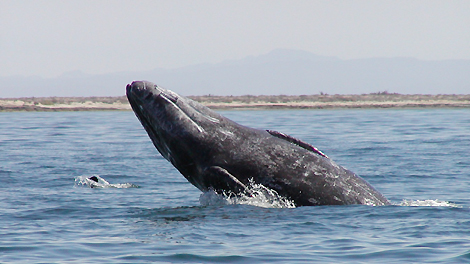PORT ANGELES, Wash. - A new genetic study could result in restrictions on where the Makah tribe can hunt for gray whales, prompting a review of the results by the National Oceanic and Atmospheric Administration, which is now conducting its own new gray whale research.
The study by two Canadian scientists suggests that approximately 200 of the behemoths, which annually feed during summer in areas that include the Washington state coast, including Strait of Juan de Fuca and Clayoquot Sound off Vancouver Island, have a separate genetic identity from the rest of the gray whale population, the authors said in a June 21 five-page summation of the study.
Since the mid-1990s, when the cetacean was removed from the endangered species list, the Makah have asserted their right to hunt whales off the Washington coast under the 1855 Treaty of Neah Bay, hunting and killing one whale in a legal hunt in 1999.
In practice, this means that any examination of potential impacts on this population starts with a pool of 200 whales . . . rather than the approximately 20,000 whales in the eastern Pacific population overall, said study authors Jim Darling of Tofino, a biologist, and geneticist Tim Frasier of St. Mary's University in Halifax, Nova Scotia.
It is probable that the National Marine Fisheries Service and/or Makah will now redo our study before they are willing to accept it -- this kind of thing is never a bad thing in science.
Frasier and Darling examined the whales' mitochondrial DNA, which is passed on only from mother to offspring, discovering DNA sequences that led the scientists to believe that the Washington-area whale population was different from the rest of the 20,000-odd eastern North Pacific gray whale population.
The offspring return to the feeding grounds of their mother, Darling said in an interview.
This is the first hint of social organization in this species, period, anywhere.
Darling said a similar feeding pattern has not been shown in gray whales before and could have whale management implications for Makah whaling.
That's because the whales displayed a separate genetic identify from the rest of the eastern Pacific herd (that spends the summer on feeding grounds in the Bering and Chukchi seas), Frasier and Darling said.
The study refers to the whales as Vancouver Island summer residents.
The Makah were given permission to whale from the federal government and a quota from the International Whaling Commission, to which the Darling-Frasier study was presented at its annual meeting in May in Morocco.
The IWC said the study deserved further review.
Under that IWC quota, granted in 1997, canoe-borne Makah whalers dispatched off Neah Bay one whale -- on May 17, 1999 -- with harpoons followed by a blast from a .50-caliber rifle.
They tried unsuccessfully again in 2000. Litigation and new permitting requirements have held up future approved whaling. Five whalers killed a whale without permission in 2007.
In May 2007, the IWC granted the tribe a new harvest of up to 20 whales over five years and up to four a year.
But now, the Frasier-Darling study has added a new wrinkle to the tribe's effort to whale, prompting a similar study of the gray whale population by NOAA -- which oversees NMFS -- that began last month and will be concluded by December, said Donna Darm, a NOAA assistant regional administrator.
In a statement issued on behalf of the tribe by Seattle lawyer Brian C. Gruber late Friday, the tribe said it will work with the IWC and NOAA in evaluating the study as it relates to the tribe's ongoing Marine Mammal Protection Act waiver application, in which the tribe pledges to hunt only migrating whales.
The tribe will also be conducting intensive research, in collaboration with NOAA, regarding the genetics of gray whales that feed off the Washington, Oregon and British Columbia coasts and in other parts of the eastern Pacific Ocean, the statement said.
Whaling opponent Margaret Owens of Joyce, co-founder of Peninsula Citizens for the Protection of Whales, was encouraged by the Darling-Frasier study.
It's a game changer, she said. This explains why these whales do need to be protected.
In the Darling-Frasier study, tissue samples were extracted with a crossbow that shot darts off the whales' skin.
Samples were taken from 40 of the 200 whales Frasier and Darling identified as being summer feeders.
Those results were compared with previously collected genetic data from 83 whales in a much-studied calving lagoon off the coast of Mexico that may not provide a large enough samples to compare with the southern feeding group whales, Darm said.
They might already be comparing them to a segregated group, she said, noting that might blur the results.
The NOAA study will include data from the Frasier-Darling paper and from tissue samples now being extracted from whales in the Bering and Chukchi seas.
It will be submitted to the International Whaling Commission by the end of the year, Darm said.
NOAA does not recognize the southern feeding group whales as a distinct biological group, but as part of the overall herd of 20,000 eastern north Pacific gray whales that migrate back and forth from Mexico and California to Alaska every year, Darm said.
This is an important piece of information that we are evaluating, she added.
If it is a separate stock that has to be managed, she said, it would have to be taken into account.
The IWC refers to the summer population as the Pacific Coast Feeding Group.
But Darm also stressed it's too soon to say what impact the study will have, adding that the Makah currently want to hunt migrating whales from Dec. 1 to May 31 -- not during summer.
The Makah explicitly ruled out hunting the summer population as part of their Marine Mammal Protection Act waiver application.
Darm said it's possible the Makah would have to hunt farther out in the Pacific to draw from a larger sample of whales so the smaller population is not compromised, she added.
Even then, there's an 18 percent to 20 percent chance that the Makah could target a southern feeding group whale while hunting migrating whales, but that's according to sightings within a mile off shore, Darm said.
The tribe's whaling tradition dates back 1,500 years, is connected to a tradition of providing food and other products for the tribe and is seen as central to tribal culture.
The Darling-Frasier study validates all the concerns we've had about issuing the quota from this group of resident whales, Owens said.
But Makah Tribal Council member Micah McCarty, a former tribal chairman, challenged Darling's objectivity.
I personally don't believe his work is unbiased or objective science, he said, adding Darling objected to Makah whaling efforts in the beginning.
Darling authored a July 14, 1999, newspaper column for the Vancouver Sun in which he criticized the U.S. government for not addressing summer resident populations of whales -- long before his study asserted that there was, indeed, a genetically distinct whale population.
I remember how emotionally charged he was, McCarty added.
But Darling said he began taking samples for the study in 1995 and has long noticed, as have others, that the same whales feed in the Strait during summer, year after year.
We are all trying to find the truth here, Darling said.
He said his study's validity was bolstered by the International Whaling Commission concluding that his distinct-whale-population hypothesis is plausible after the study was presented to the IWC in May.


